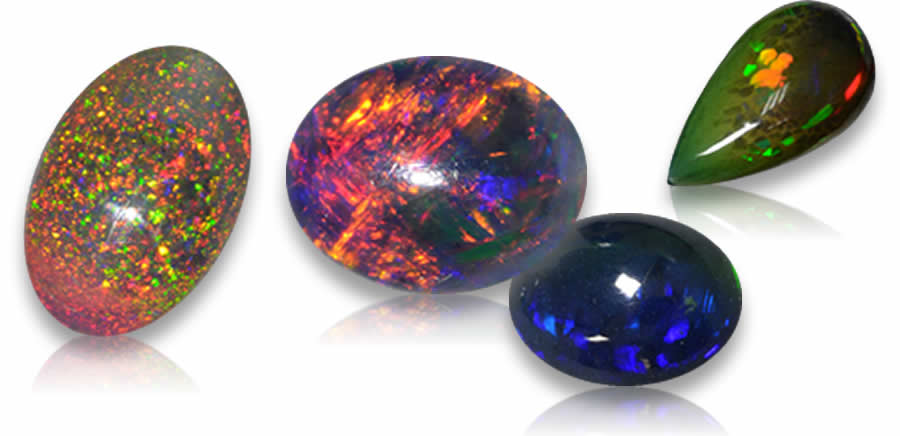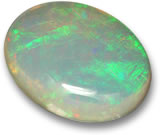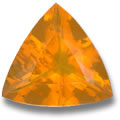Black Opal Gemstone Information


About Black Opal - History and Introduction
Black opals stand out as some of the most captivating gemstones out there, with their dark backgrounds highlighting a stunning play of colors. They're incredibly popular, and back in 2008, Australia made it official by naming black opal the state gemstone for New South Wales. While common opal represents the whole country - since Australia supplies about 97% of the world's opal - black opal gets its spotlight from mines in New South Wales.
Among all opal types, black opal tops the list in value, especially those from Lightning Ridge in Australia. These gems often include bits of common opal, but what sets them apart is the dark body tone that makes the colorful flashes - known as "fire" - pop dramatically. You'll see shifts in reds, greens, blues, oranges, and yellows as the stone moves. It's this vivid display that makes black opal the priciest opal around. Pretty cool, right?
Identifying Black Opal
Spotting black opals is straightforward thanks to their dark body tone, which differs from lighter common opals. But telling natural, untreated black opal from lab-created or enhanced versions? That usually requires lab equipment. If a stone looks overly perfect with flawless patterns and colors, it might be treated. Real untreated black opals almost always have unique flaws that give them character.
Black Opal Origin and Gemstone Sources
Nearly all black opals come from northern New South Wales, with Lightning Ridge being the top producer worldwide. This area pulls out massive amounts of opal year-round. Ethiopia also supplies some, but those are often smoke-treated to darken the tone. Nothing matches the quality and color of Australian black opals, though.
Buying Black Opal and Determining Black Opal Gemstone Value
Black Opal Color
Black opal's body tone spans from dark gray to true black, serving as a perfect canvas for its spectrum of colors. Don't let the name fool you - it can show a full rainbow through its play of color. The best ones reflect every hue vividly. Traces of iron oxide and carbon give black opal its distinct traits, making colors appear brighter than in other opals. Yellows, blues, and greens are common, but violets, fiery reds, and oranges are the rarest and most prized.
Black Opal Clarity and Luster
These gems are usually translucent to opaque, with visible inclusions like patches of common opal. Watch out for crazing - those surface cracks from drying - which can ruin a stone's value. Black opal should have a waxy luster without looking artificial or plastic-like.
Black Opal Cut and Shape
The cut often depends on the rough stone's shape. Ovals are popular as cabochons, but teardrops and trillions work too. Many have low domes due to thin color bars; if too thin, doming might not even be possible.
Black Opal Treatment
Australian black opals are generally untreated. Ethiopian ones often undergo smoke treatment to boost color depth. Newer methods include sugar soaking followed by sulfuric acid and heating for a darker tone. Coatings or impregnations with polymers, resins, or oils might stabilize the stone, so buyers should stay informed.
Black Opal Gemological Properties
| Chemical Formula: | SiO2_nH2O Hydrous silicon dioxide |
| Crystal Structure: | Amorphous |
| Color: | All colors, play of color |
| Hardness: | 5.5 - 6.5 on the Mohs scale |
| Refractive Index: | 1.37 - 1.52 |
| Density: | 1.98 - 2.50 |
| Cleavage: | None |
| Transparency: | Opaque, translucent to transparent |
| Double Refraction | None |
| Dispersion: | None |
| Pleochroism | None |
Black Opal Gemstone Varieties or Other Similar Gemstones

Opals come in many forms, either precious or common. Stones like ammonite, labradorite, mother-of-pearl, and moonstone might get confused with opal at times. For in-depth information on opal gemstones and their varieties, explore further resources.
Most Popular Similar or Related Gemstones and Trade Names
Chocolate opal, boulder opal, fire opal, common opal, white opal, opal in matrix, and opal doublets are among the favorites.
Lesser Known Similar or Related Gemstones and Trade Names
Rarer types include layer opal, agate opal, angel skin opal, wood opal, honey opal, hyalite, hydrophane opal, porcelain opal, moss opal, jelly opal, crystal opal, harlequin opal, opal triplets, girasol, prase opal, pipe opal, and wax opal.
Black Opal Gemstone Mythology, Metaphysical and Healing Powers
An ancient Australian Aboriginal story says the Creator descended on a rainbow with a peace message, and where his foot touched, stones sparked to life - creating opal.
Opals are thought to boost originality and creativity. Being porous, they can absorb thoughts and emotions, amplifying them. Black opals bring strong karma, symbolizing justice and offering protection. Opal is October's birthstone, linked to astrological benefits.
| Disclaimer: Metaphysical and Alternative Crystal Healing Powers and Properties are not to be taken as confirmed advice. Should you have any medical conditions, please see a licensed practitioner. This information is not to replace the advice of your doctor and GemSelect does not guarantee any claims or statements made. Gemselect cannot be held liable under any circumstances. |
Black Opal Gemstone and Jewelry Design Ideas
Opting for loose opals gives you more flexibility than pre-set jewelry. Settings can hide flaws, so loose stones let you assess quality better and find unique designs at good prices.
Even though they're softer, black opals work well in men's rings due to their dark, mysterious vibe. They're great for pendants, earrings, brooches, cufflinks, or tie-tacks. For rings, go with protective bezel settings to keep them safe.
Note: Buy colored gemstones by size and not by carat weight. Colored stones vary in size-to-weight ratio. Some stones are larger and others are smaller than diamonds by weight in comparison.
Black Opal Gemstones and Jewelry Care and Cleaning

Opals hold a lot of water - up to 21% of their weight - which makes them prone to crazing from dehydration. Those cracks can spoil the stone, so storage matters. Avoid sudden temperature changes. Keep opals in a sealed plastic bag with a damp cloth or cotton ball to maintain moisture.
With hardness between 5.5 and 6.5, they scratch easily. Clean by rinsing in warm water and wiping with a soft cloth. Skip bleach, chemicals, or ultrasonic cleaners - the vibrations could crack them. Remove opal jewelry before chores or sports.
Repairing damaged opals is tricky and experimental, like filling cracks with polymers or resins. Often, it's easier to replace than fix. For a complete guide on caring for opal gemstones, additional details are available.
Frequently Asked Questions
What makes black opal different from other opals?
Black opal has a dark body tone that enhances its play of colors, making the flashes more vivid compared to lighter common opals.
Where do most black opals come from?
The majority are mined in Lightning Ridge, New South Wales, Australia, known for the highest quality stones.
How can I tell if a black opal is treated?
Natural untreated opals often have flaws; overly perfect ones might be enhanced. Lab testing is best for confirmation.
What colors are most valuable in black opal?
Fiery reds, oranges, and violets are the rarest and most sought after, while yellows, blues, and greens are more common.
How should I care for my black opal jewelry?
Store in a moist environment to prevent drying, clean with warm water and a soft cloth, and avoid harsh chemicals or ultrasonics.

